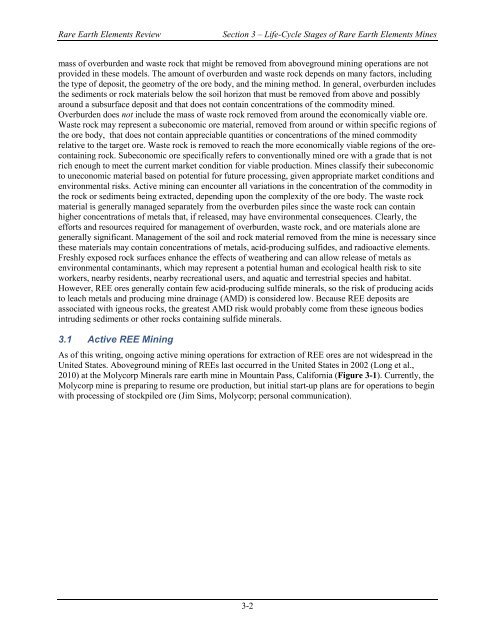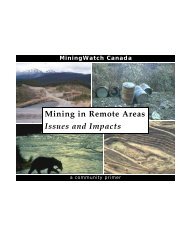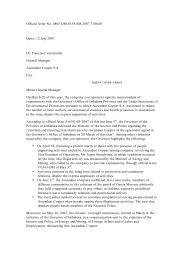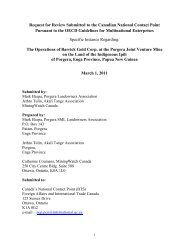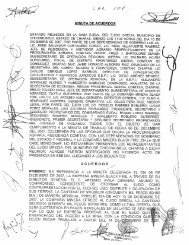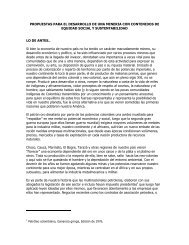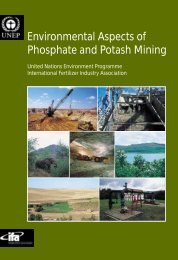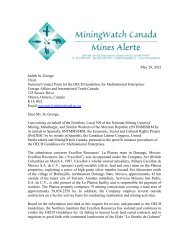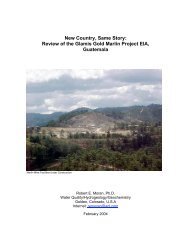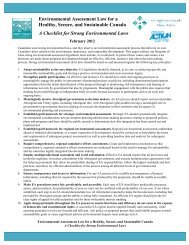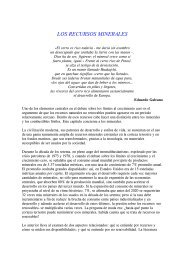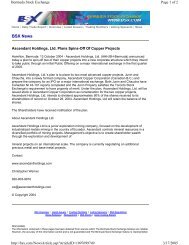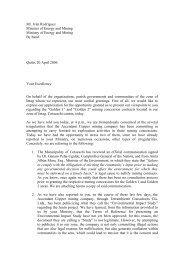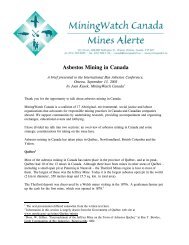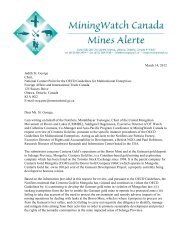Rare Earth Elements: A Review of Production, Processing ...
Rare Earth Elements: A Review of Production, Processing ...
Rare Earth Elements: A Review of Production, Processing ...
Create successful ePaper yourself
Turn your PDF publications into a flip-book with our unique Google optimized e-Paper software.
<strong>Rare</strong> <strong>Earth</strong> <strong>Elements</strong> <strong>Review</strong><br />
Section 3 – Life-Cycle Stages <strong>of</strong> <strong>Rare</strong> <strong>Earth</strong> <strong>Elements</strong> Mines<br />
mass <strong>of</strong> overburden and waste rock that might be removed from aboveground mining operations are not<br />
provided in these models. The amount <strong>of</strong> overburden and waste rock depends on many factors, including<br />
the type <strong>of</strong> deposit, the geometry <strong>of</strong> the ore body, and the mining method. In general, overburden includes<br />
the sediments or rock materials below the soil horizon that must be removed from above and possibly<br />
around a subsurface deposit and that does not contain concentrations <strong>of</strong> the commodity mined.<br />
Overburden does not include the mass <strong>of</strong> waste rock removed from around the economically viable ore.<br />
Waste rock may represent a subeconomic ore material, removed from around or within specific regions <strong>of</strong><br />
the ore body, that does not contain appreciable quantities or concentrations <strong>of</strong> the mined commodity<br />
relative to the target ore. Waste rock is removed to reach the more economically viable regions <strong>of</strong> the orecontaining<br />
rock. Subeconomic ore specifically refers to conventionally mined ore with a grade that is not<br />
rich enough to meet the current market condition for viable production. Mines classify their subeconomic<br />
to uneconomic material based on potential for future processing, given appropriate market conditions and<br />
environmental risks. Active mining can encounter all variations in the concentration <strong>of</strong> the commodity in<br />
the rock or sediments being extracted, depending upon the complexity <strong>of</strong> the ore body. The waste rock<br />
material is generally managed separately from the overburden piles since the waste rock can contain<br />
higher concentrations <strong>of</strong> metals that, if released, may have environmental consequences. Clearly, the<br />
efforts and resources required for management <strong>of</strong> overburden, waste rock, and ore materials alone are<br />
generally significant. Management <strong>of</strong> the soil and rock material removed from the mine is necessary since<br />
these materials may contain concentrations <strong>of</strong> metals, acid-producing sulfides, and radioactive elements.<br />
Freshly exposed rock surfaces enhance the effects <strong>of</strong> weathering and can allow release <strong>of</strong> metals as<br />
environmental contaminants, which may represent a potential human and ecological health risk to site<br />
workers, nearby residents, nearby recreational users, and aquatic and terrestrial species and habitat.<br />
However, REE ores generally contain few acid-producing sulfide minerals, so the risk <strong>of</strong> producing acids<br />
to leach metals and producing mine drainage (AMD) is considered low. Because REE deposits are<br />
associated with igneous rocks, the greatest AMD risk would probably come from these igneous bodies<br />
intruding sediments or other rocks containing sulfide minerals.<br />
3.1 Active REE Mining<br />
As <strong>of</strong> this writing, ongoing active mining operations for extraction <strong>of</strong> REE ores are not widespread in the<br />
United States. Aboveground mining <strong>of</strong> REEs last occurred in the United States in 2002 (Long et al.,<br />
2010) at the Molycorp Minerals rare earth mine in Mountain Pass, California (Figure 3-1). Currently, the<br />
Molycorp mine is preparing to resume ore production, but initial start-up plans are for operations to begin<br />
with processing <strong>of</strong> stockpiled ore (Jim Sims, Molycorp; personal communication).<br />
3-2


